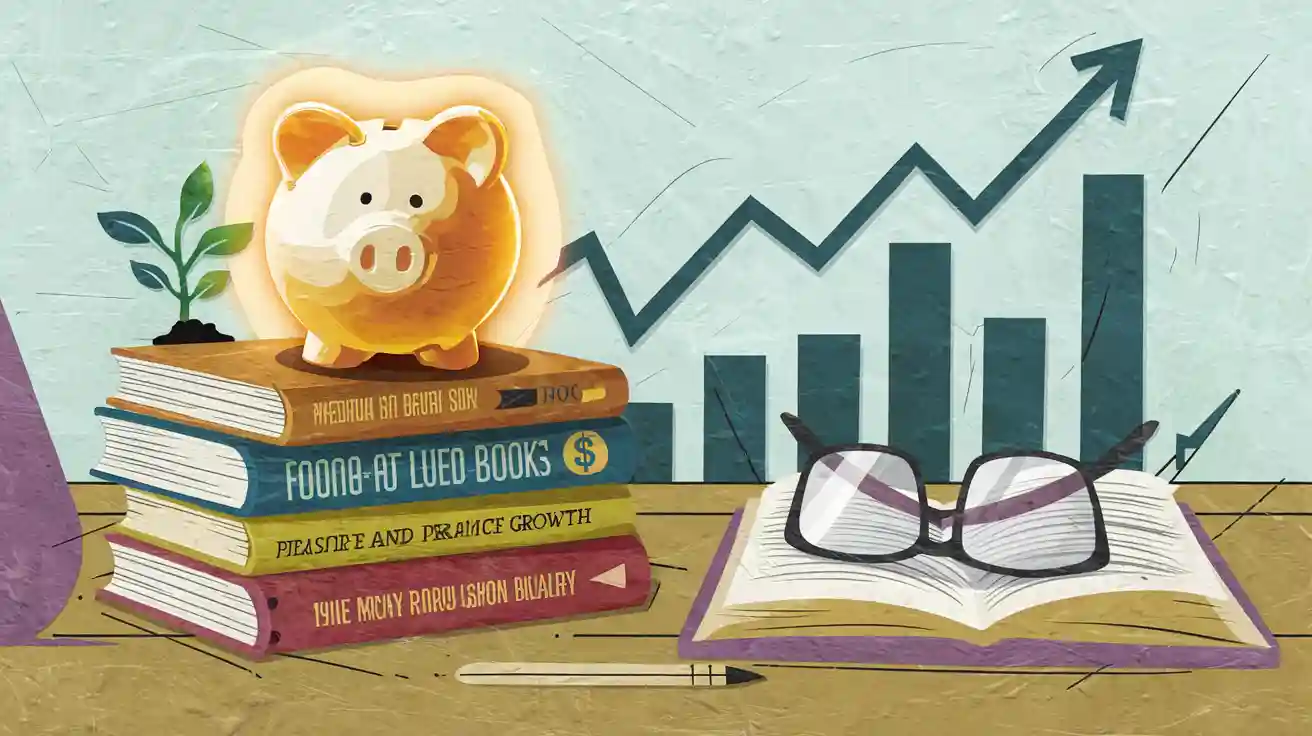
Imagine waking up 30 days from now with a completely transformed perspective on money. Sounds exciting, right? To truly transform your money mindset isn’t just possible—it’s achievable with small, consistent steps. Every day, you have the chance to shift your mindset and take control of your financial future.
Your beliefs about money shape your decisions. If you’ve ever felt stuck or limited, it’s time to break free. This 30-day journey is your opportunity to let go of old habits and create clarity around your finances. Visualize yourself achieving your money goals. You can do this! Grab a money mindset journal prompt, commit to the challenge, and start building the freedom you deserve.
Key Takeaways
Find and question thoughts that hold you back about money.
Make clear money goals and check your progress every day.
Save for emergencies and learn simple investing to stay secure.
Look at your progress often and change goals to keep growing.
Reward yourself in ways that match your money goals to stay inspired.
Week 1: Laying the Foundation for a New Money Mindset
Assess Your Current Money Mindset
Identify limiting beliefs about money.
Before you can change your money mojo, you need to understand what’s holding you back. Many people unknowingly carry limiting beliefs about money that hinder their financial growth. Do any of these sound familiar?
“There’s never enough money.”
“Money management is too complex.”
These beliefs can create unnecessary stress and prevent you from reaching your money goals. Take a moment to write down any negative thoughts you have about money. Once you identify them, you can start replacing them with empowering beliefs like, “I am capable of managing my finances effectively.”
Reflect on your financial habits and their impact.
Your daily habits shape your financial reality. Are you tracking your spending? Do you prioritize saving? Reflect on how your current habits align with your personal financial plan. For example, if you often spend impulsively, it might be time to focus on mindful spending. Awareness is the first step toward meaningful change.
Create a 30 Day Money Mindset Challenge Plan
Set clear intentions for the challenge.
A successful 30 day money mindset challenge starts with clear intentions. What do you want to achieve? Maybe you want to save $500 or finally create a personal financial plan. Write down your goals and keep them visible. This will keep you motivated throughout the challenge.
Use tools like journals or planners to track progress.
Tracking your progress is key to staying on course. Tools like Strides: Habit Tracker or The Five Minute Journal can help you monitor your goals and reflect on your journey. These tools make it easier to stay consistent and celebrate small wins along the way.
Build Awareness of Your Finances
Track daily income and expenses.
To change your money mojo, you need to know where your money is going. Start by tracking your daily income and expenses. This simple habit enhances financial awareness and helps you identify unnecessary spending. It also reduces financial stress by giving you a clear picture of your finances.
Identify areas for improvement in spending habits.
Once you’ve tracked your expenses, look for patterns. Are you spending too much on dining out or subscriptions you don’t use? Small changes, like cooking at home or canceling unused services, can free up money for your savings or investment goals. Every dollar saved brings you closer to financial freedom.
Week 2: Building Wealth and Financial Confidence

Develop a Savings and Investment Strategy
Start an emergency fund and automate savings.
Creating an emergency fund is one of the smartest steps you can take to secure your financial future. Start small and make it manageable:
Set up automatic transfers from your paycheck to a dedicated savings account.
Save unexpected income, like bonuses or tax refunds, directly into your fund.
Gradually increase your savings amount over time.
“The best way to build up emergency fund savings when cash flow is tight is to take tiny steps that add up over time,” says Noah Damsky, a chartered financial analyst.
Once you reach your initial goal, keep saving. This ensures you’re prepared for larger emergencies and building wealth over time.
Learn the basics of investing and take small steps.
Investing can feel overwhelming, but starting small makes it easier. Begin with these basics:
Understand the risk ladder. Cash is the safest, while alternative investments carry higher risks.
Consider index funds or ETFs, which are great for beginners.
Diversify your investments to reduce risk.
Remember, the stock market has historically provided higher returns than bonds over the long term. Taking small, consistent steps will help you grow your money confidently.
Practice Daily Money Mindset Exercises
Use affirmations to reinforce positive beliefs.
Positive affirmations can transform your money stories. Write them in a journal or say them out loud daily. For example:
“I am capable of achieving financial success.”
“Money flows to me easily and abundantly.”
This simple habit shifts your mindset from scarcity to abundance, helping you believe in your financial potential.
Visualize financial success and abundance.
Visualization is a powerful tool. Picture yourself achieving your financial goals. Imagine paying off debt, growing your savings, or enjoying financial freedom. Visualization aligns your thoughts and actions with your goals, reduces stress, and boosts motivation.
Protect Your Financial Future
Review insurance and debt management strategies.
Protecting your financial future starts with preparation. Review your insurance policies to ensure they cover unexpected events. For debt, focus on high-interest loans first. Make more than the minimum payments to reduce interest costs and free up money for savings.
Create a plan to eliminate high-interest debt.
High-interest debt can hold you back. Use the debt avalanche method to prioritize paying off the highest-interest debts first. Cut unnecessary expenses and allocate those funds toward debt repayment. Consolidating debts into a lower-interest loan can also simplify payments and save money.
Week 3: Expanding Knowledge and Transforming Your Money Mindset
Deepen Your Understanding of Investments
Explore advanced investment options like ETFs or index funds.
Investing is a powerful way to grow your wealth, but it’s important to understand your options. Exchange-Traded Funds (ETFs) and index funds are great choices for beginners and seasoned investors alike. They offer diversification, which means your money is spread across multiple assets, reducing risk. ETFs trade like stocks, making them flexible, while index funds track market indexes, providing steady returns over time. Start small and research which option aligns with your financial goals.
Learn about the power of compound interest.
Compound interest is often called the eighth wonder of the world—and for good reason. It allows your money to grow exponentially over time. Here’s an example:
Alma invests $10,000 at age 31 and lets it grow for 20 years. By age 50, her investment has grown significantly.
Dave, on the other hand, starts investing $2,000 annually at age 41 for 10 years. Despite investing more, he ends up with less than Alma.
This shows that starting early and letting your investments compound over time leads to greater financial growth. The sooner you start, the bigger the impact.
Master Taxes and Financial Planning
Research tax-saving strategies and deductions.
Taxes can take a big bite out of your income, but smart planning can help you save. Look into deductions like retirement contributions, education expenses, or home office costs if you work remotely. Tax-advantaged accounts, such as 401(k)s or IRAs, not only reduce your taxable income but also help you save for the future. Staying informed about tax laws ensures you keep more of your hard-earned money.
Consider consulting a financial advisor for guidance.
If taxes and financial planning feel overwhelming, you don’t have to go it alone. A financial advisor can help you create a personalized plan, identify tax-saving opportunities, and guide you toward long-term financial stability. Think of it as an investment in your financial transformation.
Shift to a Growth-Oriented Money Mindset
Read books or listen to podcasts on financial success.
Expanding your knowledge is key to a mindset transformation. Dive into resources that inspire and educate. Some great books include:
You Are a Badass at Making Money by Jen Sincero: Encourages you to embrace fear and take risks.
Overcoming Underearning by Barbara Stanny: Helps uncover and address childhood money issues.
Get Rich, Lucky Bitch by Denise Duffield-Thomas: Offers practical advice and personal stories.
Prefer podcasts? Check out:
Personal Finance for PhDs by Dr. Emily Roberts: Tailored for academics.
Be Wealthy and Smart with Linda P. Jones: Simplifies complex financial topics in short episodes.
Surround yourself with financially empowered individuals.
Your environment plays a huge role in your transformation. Spend time with people who have a positive relationship with money and are working toward financial freedom. Join online communities, attend workshops, or network with like-minded individuals. Their habits and mindset will inspire you to stay on track and keep growing.
Week 4: Achieving Financial Freedom and Celebrating Progress

Refine and Reassess Your Financial Goals
Evaluate progress and adjust goals as needed.
As you near the end of your 30-day transformation, take a moment to evaluate your progress. Look back at the goals you set at the start of this challenge. Have you achieved them, or do they need adjustment? Maybe you’ve saved more than expected or realized a goal was too ambitious. Adjusting your goals isn’t a setback—it’s a sign of growth. Use what you’ve learned to refine your approach and keep moving forward.
Break larger goals into smaller, actionable steps.
Big goals can feel overwhelming, but breaking them into smaller steps makes them manageable. For example, if your goal is to save $10,000, start by focusing on saving $500 each month. Smaller milestones keep you motivated and make the journey less daunting. Celebrate each step you complete—it’s all part of building sustainable financial habits.
Leverage Tools for Long-Term Success
Use apps for budgeting, tracking, and planning.
Technology can simplify your financial journey. Here’s a quick look at some app features that can help:
Feature | Description |
|---|---|
Personalized Budget Plan | Automatically creates a budget based on actual expenses and income. |
Monthly Progress Tracking | Allows users to track budget progress and account balances easily. |
Transaction Reconciliation | Helps reconcile budget plans with actual transactions for clarity. |
AI-Powered Money Coach | Provides guidance for smarter financial decisions. |
Shared Accounts | Enables collaboration on finances with trusted partners. |
Financial Profiles | Organizes finances with multiple profiles for different budgets. |
These tools make it easier to stay on top of your finances and maintain the habits you’ve built during this challenge.
Explore tools like retirement calculators or debt payoff planners.
Planning for the future is just as important as managing the present. Tools like retirement calculators can help you assess your savings and plan for long-term goals. Debt payoff planners, on the other hand, show you how to eliminate debt efficiently. Here’s a quick overview of some helpful tools:
Tool Name | Purpose |
|---|---|
Retirement calculators | Assess savings and plan for retirement. |
Power of savings | Demonstrates how small contributions grow over time. |
Risk Simulator | Assesses risk tolerance through market simulations. |
Debt Illustrator | Charts debt and shows potential payoff dates. |
Budget Worksheet | Guides budgeting and managing finances effectively. |
Retirement Budget Worksheet | Evaluates retirement expenses and creates a budget. |
These tools empower you to make informed decisions and stay on track for financial freedom.
Celebrate Your 30 Day Money Mindset Challenge Success
Reflect on the mindset shifts and habits you’ve developed.
Take a moment to reflect on how far you’ve come. Over the past 30 days, you’ve built new habits, shifted your mindset, and taken control of your finances. These changes are worth celebrating! Recognizing your progress boosts morale, enhances motivation, and reinforces positive behaviors. It also instills hope for future achievements.
Reward yourself in a way that aligns with your financial goals.
Celebrating doesn’t mean splurging. Instead, reward yourself in ways that align with your financial goals. For example, treat yourself to a meaningful experience, like a day trip or a special meal, rather than extravagant spending. Setting milestone rewards for smaller achievements can also keep you motivated. Balancing short-term gratification with long-term goals ensures your celebrations contribute to both happiness and financial well-being.
Congratulations on completing your 30-day money mindset challenge! Over the past month, you’ve taken meaningful steps to transform your relationship with money. Here’s what you’ve achieved:
Learned the basics of personal finance and budgeting.
Built an emergency fund and explored saving strategies.
Gained confidence in investing and planning for future goals.
Reflected on emotional ties to money and celebrated progress.
By practicing these habits daily, you’re setting yourself up for long-term success. A solid financial plan keeps you focused on your goals, while managing debt brings peace of mind. Building a retirement nest egg becomes a powerful motivator as you move closer to financial freedom.
Remember, challenges may arise. Past experiences or cultural beliefs can influence your mindset, but tools like budgeting apps or affirmations can help you stay on track. Keep learning, stay consistent, and embrace financial growth as a lifelong journey. You’ve got this!
FAQ
What if I miss a day during the 30-day challenge?
Don’t worry! Missing a day doesn’t mean you’ve failed. Just pick up where you left off and keep going. Progress is more important than perfection. Focus on consistency over time, and you’ll still see results.
How much money should I save during this challenge?
It depends on your financial situation. Start small—maybe $5 or $10 a day. The key is building the habit of saving. Over time, you can increase the amount as your confidence and financial awareness grow.
Do I need special tools to complete the challenge?
Not at all! A simple notebook or a free budgeting app works perfectly. Tools like Mint or YNAB can help track your progress, but the most important thing is your commitment to the process.
Can I still participate if I have debt?
Absolutely! This challenge is designed to help you manage your finances, including debt. Focus on creating a plan to tackle high-interest debt while building better money habits. Small steps, like cutting unnecessary expenses, can make a big difference.
How do I stay motivated throughout the 30 days?
Set reminders and celebrate small wins. Use affirmations or visualize your financial goals daily. You can also join online communities or find an accountability partner to keep you inspired and on track.






